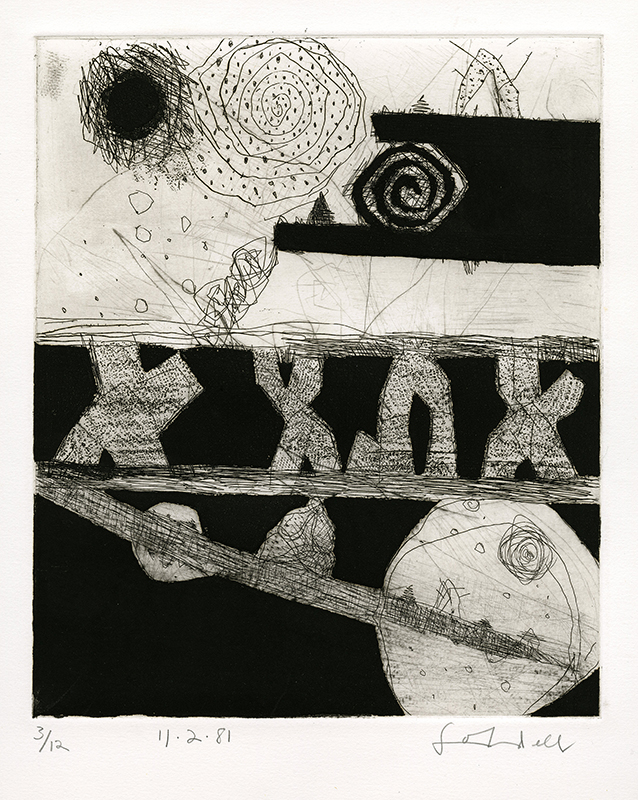11.2.81 is an intaglio, a combination of softground and line etching, sugarlift aquatint, and drypoint, created in 1981 by American artist Frank Lobdell. It is pencil signed and dated in the lower margin, and editioned 3/12. Ikuru Kuwahara printed the edition for the publisher, Three Equal Partners (3EP) of Palo Alto. The platemark measures 11-7/8 x 9-7/8 inches. 11.21.81 is illustrated on page 257 in Frank Lobdell: The Art of Making & Meaning and the reference is Lobdell and Burgard no. 38.
Most of Lobdell’s color monotypes and intaglios are designated by the month, day and year of execution rather than a formal title. For the viewer, this approach eliminated any prejudgment caused inadvertently by a title. The partners of Three Equal Partners were artist Joseph Goldyne, art dealer Paule Kirkeby, and collector Mary Anderson.
Frank Lobdell, painter, printmaker, and teacher, was born in Kansas City, Missouri on 23 August 1921. During 1938 and 1939, Lobdell attended the Saint Paul School of Fine Art in Minnesota where he was a student of Cameron Booth. Walt Kuhlman was also a student and he and Lobdell became a lifelong-friends. In 1940, the pair viewed the Picasso exhibition at the Art Institute of Chicago.
During World War II, Lobdell served in the US Army between 1942 and 1946. After the war, he settled in Sausalito, California and, in 1947, he enrolled in the California School of Fine Arts in San Francisco under the GI Bill. Kuhlman also attended the CSFA and he, Lobdell, Richard Diebenkorn, John Hultberg, George Stillman and James Budd Dixon eventually became known as the Sausalito Six. Five of this group were included in the 1948 exhibition 5 Young Moderns at the Seashore Gallery of Modem Art in Sausalito. Lobdell knew the printer Eric Ledin of Mill Valley and had access to his offset lithography press. He gave the artists paper plates to draw upon and the six of them produced the first Abstract Expressionist portfolio in 1948 which was entitled Drawings. The series began with seventeen offset lithographs but eventually one of the plates broke down and most portfolios contain sixteen prints.
Lobdell left for Paris in 1951 where he enrolled in the Académie de la Grande Chaumière. Walt Kuhlman joined him in Paris and they were included in the exhibition 6eme Salon des Realites Nouvelles at the Petit Palais in 1951. That same year Lobdell returned to San Francisco and established a studio. His distinguished teaching career began in 1957 at the California School of Fine Arts where, according to art historian and critic Thomas Albright, “he was one of the most influential teachers.” In 1966, Lobdell was Artist-in-Residence at Stanford University and he joined the Stanford faculty the following year. He was Professor of Art until his retirement from Stanford in 1991.
Lobdell exhibited internationally and honors bestowed on his work include the first Nealie Sullivan Award by the San Francisco Art Association and the Medal for Distinguished Achievement in Painting from the American Academy and Institute of Arts and Letters.
His work is represented in the collections of the Harvard Art Museums, Cambridge, Massachusetts; the Art Institute of Chicago, Illinois; the Amon Carter Museum of American Art, Fort Worth, Texas; the British Museum, London; the Los Angeles County Museum of Art, California; the Museum of Modern Art, New York; the Oakland Museum of California; the Norton Simon Museum, Pasadena; the Portland Art Museum, Oregon; the Fine Arts Museums of San Francisco, California; the San Jose Museum of Art, California; and the National Gallery of Art, the Phillips Collection, and the Smithsonian American Art Museum, Washington, D.C.
Frank Lobdell died in Palo Alto, California on
December 14, 2013.



